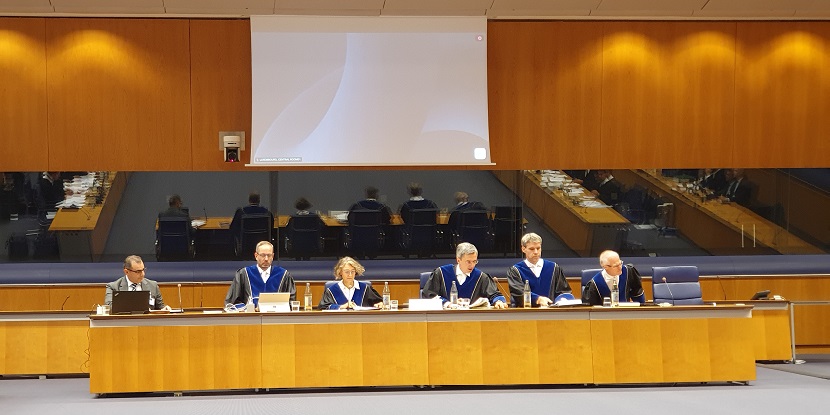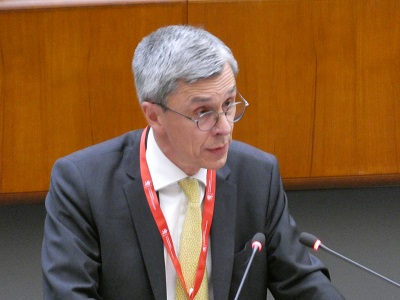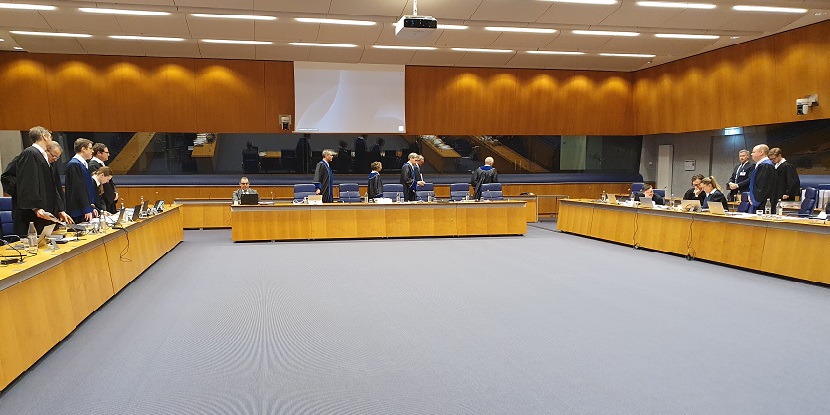10x Genomics and NanoString yield no ground in first UPC Court of Appeal hearing
On Monday, the UPC Court of Appeal in Luxembourg heard its first case. 10x Genomics and NanoString fought hard in their appeal against a preliminary injunction, with the judges led by presiding judge Klaus Grabinski putting both opponents under intense scrutiny. While the outcome remains completely open, their conduct of the negotiations will have an impact on future UPC proceedings. JUVE Patent reports directly from the hearing.
20 December 2023 by Mathieu Klos
The oral hearing at the European Convention Centre on Luxembourg’s Kirchberg, between 10x Genomics and NanoString, began with UPC Court of Appeal president, Klaus Grabinski, clarifying what this Monday morning was all about. “This is a historic moment”, he says. “It is the first ever hearing of this court.”
The Court of Appeal is the highest instance in the UPC system and, on 18 December 2023, heard a case for the first time – a good six months after the UPC began its work. On the agenda was NanoString’s appeal against a PI ruling by the Munich local division in the dispute with 10x Genomics.
And the neighbourhood for this historic moment in European patent law could hardly be more exclusive. The European Court of Justice (CJEU) is just across the street on the other side of Avenue John F. Kennedy. However, as thick clouds of grey fog enveloped the Kirchberg, the two golden towers of the EU’s highest court shone less brightly than usual.
Grabinski introduces the case
Opposite, in the ultra-modern Convention Center, the five UPC judges around Klaus Grabinski are trying to shed light on the conflicting arguments of NanoString and 10x Genomics. At the start of the hearing, despite his introduction, the president does not spend time waxing lyrical about the historic moment. In typical German style, he quickly and pragmatically moves on to the case.

UPC president Klaus Grabinski opens the hearing. Rainer Friedrich (TQJ), Francoise Barutel, Peter Blok Cornelis Schüller (TQJ) complete the panel of the Court of Appeal ©Mathieu Klos
Following the tradition of German patent courts, Grabinski introduces the case for 45 minutes and presents the judicial panel’s view of the case. This is surprising, as the panel includes French native Francoise Barutel, and two Dutch natives in Peter Blok and the technically qualified judge, Cornelis Schüller. Another German, Rainer Friedrich, completes the panel as the second technical judge.
In other UPC countries such as France or Finland, such long introductions by the judges are not common practice. Or at least, as observers report with surprise during the first break in the proceedings, the introduction is kept very brief.
Examining the validity
Although the judges were obviously well prepared, the otherwise composed and seasoned president of the court is visibly nervous. While Grabinski’s four fellow judges look out into the auditorium with unreadable expressions, at times the president struggles to find the right words. At the agreement of both parties, the court hears the case in English, despite the Munich local division conducting the first-instance proceedings in German.

Klaus Grabinski
However, Grabinski quickly regains his confidence and conducts the hearing with charm and determination. Infringement, claim construction, validity, novelty, licence issues, and proportionality – he does not forget a single thing that belongs to a PI case.
On a large screen, a staff member displays the relevant documents. Grabinski points directly to the passages in the patent specification that the court wants to discuss with the lawyers from 10x Genomics and NanoString. “The case raises a lot of problems for both sides,” Grabinski concludes.
While the question of infringement was not discussed, the court primarily wants to discuss the urgency and proportionality – but firstly the validity – of the patent. NanoString filed an opposition at the EPO against EP 41 08 782, which belongs to Harvard University and was licensed to 10x Genomics. In addition, NanoString has filed a counterclaim for revocation against the patent with the UPC.
First days of the UPC
The stakes are high for NanoString. “Our products are no longer on the market in Europe since the ruling by the Munich local division”, NanoString’s lead counsel Oliver Jüngst will later say. The issue of unresolved validity is also why NanoString wants to intensively discuss the proportionality of the Europe-wide PI.
In the initial days of the UPC, 10x Genomics applied for the PI against NanoString’s CosMx Spatial Molecular Imager (SMI) instruments and CosMx reagents for RNA detection in the UPC jurisdictions. The US-based company alleges that the use and distribution of NanoString’s CosMx products for RNA detection infringe European patents EP 782 and EP 27 94 928.
Both patents belong to Harvard University and protect a spatial profiling technology. EP 782 is a Unitary Patent, while EP 928 is a non-opted-out European patent. EP 928 is in effect in Germany, the Netherlands and France, while EP 782 is in effect in all UPC member states.
17-state impact for NanoString
In mid-September, the Munich UPC judges announced their decision regarding EP 782. They saw the patent as most likely valid and infringed, thus granting the patent holder’s request for a PI valid in all 17 UPC member states. The judges issue the PI without the provision of a security payment, meaning it is effective without further measures (case ID: UPC_CFI_2/2023).
At the beginning of December, the same court then ordered a fine of €100,000 at the request of 10x Genomics. The US company opined that NanoString was not complying with the PI ruling. In addition to the judgment on EP 782, the Munich court denied a PI based on EP 928 in early October (case ID: UPC_CFI_17/2023).
However, in the meantime, 10x Genomics has also filed two main actions against NanoString with the UPC. In addition, the company sued another competitor, Vizgen, at the Hamburg local division for infringement of EP 782. NanoString is challenging both patents with UPC revocation actions.
Nationally, 10x Genomics and NanoString are also facing off in an intense dispute at the Munich Regional Court. The two companies are yielding nothing.
Change of location
The courtroom in Luxembourg’s Conference Center is an appropriate location for the UPC Court of Appeal’s first hearing on such an economically significant case, with its modern conference system and light beech panelling. The five judges, 15 company representatives and 15 spectators are well spread out in the modern 300-square-meter room. The actual Court of Appeal is located in the less attractive Hémicycle building, a few meters east.
From the gallery, the dark windows of the translators’ booths reflects the judicial panel. From time to time, the five judges retreat to the booth to deliberate and are dimly visible through the glass. But the audience cannot hear their discussions.
Grabinski leads the hearing according to a fixed timetable. First, the court gives both parties 90 minutes for their pleadings. After that, both sides have another 30 minutes to respond to the arguments of the other side. In the end, however, the presiding judge is flexible with the timetable, as the judges have a lot of questions for the two opposing parties.
NanoString and 10x Genomics yield nothing

Oliver Jüngst
Oliver Jüngst, Bird & Bird partner and lead counsel for NanoString, does not spend much time on questions about the infringement. The seven-strong team of lawyers instead concentrates on the validity and proportionality of the injunction.
Jüngst wants to convince the appellate court that the patent is not valid, introducing – among other things – new evidence of prior art.
Daniela Kinkeldey, patent attorney and partner at Bird & Bird, explains in detail why NanoString is convinced that EP 728 will not survive the EPO opposition and the revocation claim.
“It is a complex case that needs to be clarified in the main trial,” says Jüngst. Irreparable damage will be done to his client if the hearing ends in the wrong decision – in other words, if the court confirms the Munich local division’s PI. Jüngst therefore called on the court to at least set a security in the event that it confirms the PI.
Bird & Bird counsel Moritz Schroeder also accuses 10x Genomics of delaying the conclusion of a licence agreement. “My client is excluded from the European market,” he addresses the judges. NanoString had submitted a licence offer, which 10x Genomics rejected.
Acknowledging the auxiliary request
However, the judges are mainly asking about the validity of the patent. Of course, the decisive factor in the PI proceedings is not primarily whether the patent is actually valid, but the likelihood that it will survive the attacks. But, as Grabinski points out, “this appeal court will not decide on the revocation claims.”
However, the court must decide whether an auxiliary request by 10x Genomics to the UPC is admissible. In the first instance proceeding, the Munich local division proposed to restrict the patent if necessary, after the German Federal Patent Court published a corresponding preliminary opinion in the nullity proceedings.
Although this no longer played an important role in the first instance, the application is still pending at the Court of Appeal. The appeal judges are therefore asking both companies about this. Now NanoString is requesting to be allowed to submit written arguments again, should the issue become important for the Court of Appeal decision.
The mood shifts
As the trial progresses, there is a shift in the initially friendly atmosphere in the courtroom. The many judicial questions suggest that the parties cannot expect a clean sweep for 10x Genomics – that is, a confirmation of the PI from Munich without intensive examination. On the contrary, the court is balanced. Klaus Grabinski repeatedly extends the speaking time in order to hear the arguments of both parties.
“The judges want to avoid the accusation that they have a hasty opinion and are judging too lightly,” explains an observer during a break in the proceedings. For the UPC, these proceedings will above all set standards regarding procedural issues. Observers agree that the judges are therefore aware of their responsibility for the development of the new court.

Tilman Müller-Stoy
Tilman Müller-Stoy, lead counsel for 10x Genomics and partner at Bardehle Pagenberg, also says little on the subject of infringement. He deals only briefly with the subject of licences. Instead, the 10x Genomics lawyers focus on the defence of validity and procedural issues.
Müller-Stoy criticises NanoString for submitting the new document on prior art so soon before the trial. This, he says, meant his client could not view it in the UPC’s CMS system and it became known only during the oral hearing.
On the other hand, Oliver Jüngst counters that it is implausible that nobody on the part of 10x Genomics noticed the document in the CMS system, in view of a highly paid team of eight Bardehle Pagenberg lawyers.
The two lead counsel also lock horns when they exceed the speaking times set by the court. Klaus Grabinski ignores these lawyer skirmishes with a “yes yes” and directs the lawyers back to the case.
No Christmas presents
On the subject of the PI’s proportionality, Bardehle partner Tobias Wuttke finally goes on the attack. He accuses the other side of “sitting and waiting”, arguing that NanoString had long since developed an update in the US that circumvents the infringing object. “Why don’t you introduce this in Europe too?” he asks the other party.
He also voices doubts that the decision would have a major impact on NanoString’s existing contracts with customers. In turn, NanoString cited this to support the disproportionality of the PI order.
“Mr. Wuttke is not yet in a Christmas mood. He is very angry with us,” replies Oliver Jüngst. He also rejects the accusation that “NanoString is a notorious infringer”. Addressing the bench, Jüngst expresses doubts that 10x Genomics’ request for an injunction is “super urgent.”
All bets are off
At the end of the six-and-a-half-hour hearing, the judges lack the strength to once again acknowledge the historic moment. They retire to deliberate, one last time, on whether they should grant the parties a period of time to submit new written arguments on the new prior art document, NanoString’s auxiliary request regarding the amendment of claims, and questions arising from the parallel US proceedings.
After ten minutes the judges return to the courtroom. “No further written submissions,” explains Klaus Grabinski in a straightforward manner. The hearing is over. He leaves it open as to when the court will announce its decision, which is also different from German proceedings.

The work is done. After six and a half hours, the five Court of Appeal judges leave the hearing room. They will not publish their verdict until the new year ©Mathieu Klos
As they leave, the UPC judges wish everyone involved a safe journey home. A ‘Merry Christmas and a Happy New Year’ is also exchanged back and forth between the opposing parties. As the warm confines of the conference centre releases the attendees into the thick evening fog on Luxembourg’s Kirchberg, none of the trial observers can say whether the court will confirm or overturn the PI from Munich.
Update 21.12.2023: In the national dispute between 10X Genomics and NanoString, the Higher Regional Court of Munich yesterday ordered a stay of the enforcement of the preliminary injunction concerning EP 2 794 928. This was confirmed by both companies at the request of JUVE Patent. However, NanoString must provide a security deposit of 300,000 euros for the judgement to take effect (case ID: 6 U 2359/23).
In May 2023, the Munich Regional Court ruled against NanoString and its German subsidiary for indirect infringement of the German part of European patent EP 928 (case IDs: 7 O 2693/22 and 7 O 5812/22). 10x Genomics then enforced the judgements.
However, NanoString is still unable to sell its products in Germany. Even though the Higher Regional Court of Munich has now provisionally allowed sales again, the Unified Patent Court’s preliminary injunction from EP 4108782 remains in force.
